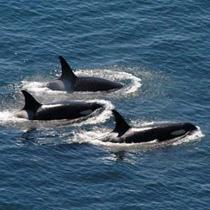About Puget Sound
Overview
Puget Sound is part of a larger marine ecosystem called the Salish Sea, which also includes the Georgia Basin in Canada and the Strait of Juan de Fuca.
There is no boundary that officially defines Puget Sound, but for regulatory purposes we refer to it as the marine areas south of the U.S.-Canada border and east of the Strait of Juan de Fuca.
- Learn how we're cooperating with Environment Canada on cross-border environmental issues.
Challenges
Humans have inhabited the Salish Sea for over 10,000 years. Over 7 million people currently live within its 42,000 square-mile watershed. By the year 2025, we expect the population to reach more than 9 million people.
The health and productivity of Puget Sound is a cornerstone of this region's quality of life, and the area's vibrant economy benefits from commercial fishing to eco-tourism.
 In the late 1800's, the orca population was estimated at over 200. Today their numbers are less than half that. Photo courtesy of Stuart Yee.It's also home to over 200 species of fish, over 100 species of birds, 20 species of marine mammals, and over 3,000 species of invertebrates.
In the late 1800's, the orca population was estimated at over 200. Today their numbers are less than half that. Photo courtesy of Stuart Yee.It's also home to over 200 species of fish, over 100 species of birds, 20 species of marine mammals, and over 3,000 species of invertebrates.
Many of these species have experienced serious declines and are at risk or vulnerable to extinction. The continued loss of these species points to declining ecosystem health that affects the economic, social and cultural well being of our communities.
- Learn how we're tracking the health of the Salish Sea ecosystem.
Solutions
We all have a common interest in protecting and restoring Puget Sound. Federal, state and tribal governments, community groups, non-profits, and municipalities are delivering protection and restoration work that's showing results.
The EPA provides federal funding to help support many of these efforts, and Washington's Puget Sound Partnership is tracking them in its Puget Sound Project Atlas. Exit
- Learn more about where EPA funding goes to help restore and protect Puget Sound.
Learn More
- Puget Sound Starts Here Exit- Public/private partnership to raise awareness about how our everyday actions can impact Puget Sound.
- Puget Sound Partnership Exit- Washington's lead state agency for protecting and restoring Puget Sound.
